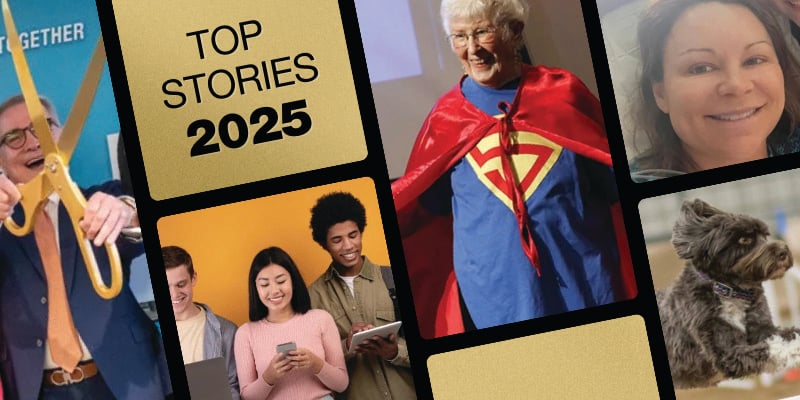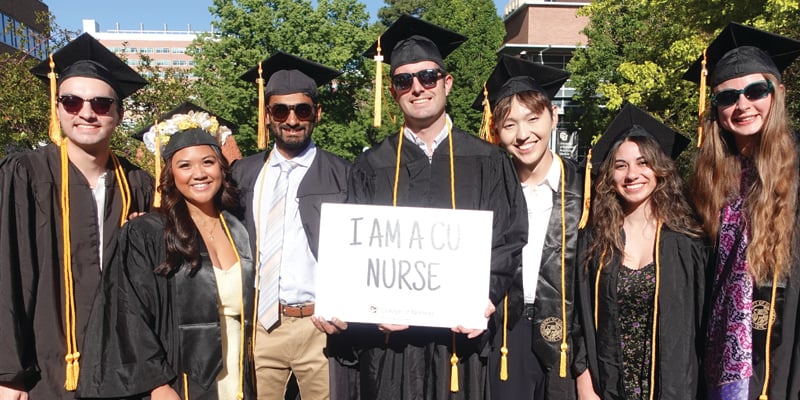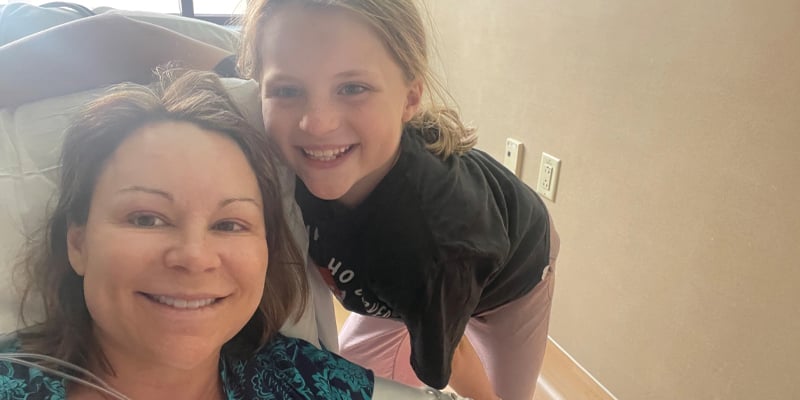From a young age, Anne Ingalls Gillespie, MSN, RN, cared deeply about animals and sick children.
“Growing up, kids would bring me injured birds and bunnies, and I would always try to fix them,” she remembers. “Originally, I wanted to be a veterinarian; but when I went to college I volunteered with a camp for children with cystic fibrosis, and I knew then that I wanted to help kids with chronic illnesses.”
More than 30 years into her nursing career, the love of animals and kids still plays a major part in Gillespie’s life’s work – which has brought joy and happiness to youngsters with life-threatening illnesses.
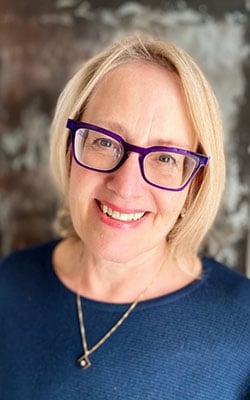
Anne Ingalls Gillespie, MSN, RN |
Currently a student at the University of Colorado College of Nursing, Gillespie is earning a Doctor of Philosophy (PhD) in Nursing with a focus on bio-behavioral science. Having completed her master’s degree, she’s working on a dissertation about an animal-assisted intervention (or AAI) program she developed while working as a pediatric oncology nurse at Children’s Hospital Colorado.
Called Youth and Pet Survivors (or YAPS®), the virtual animal-assisted therapy program connected children and adolescents with cancer with dogs and cats who survived cancer. The patients would exchange letters, photographs and mementos through correspondence with pet owners writing on behalf of their pets.
Though research suggests the program successfully gave patients a way to process the cancer experience, Gillespie essentially suspended the program in 2020 because of the pandemic and to invest her energies solely on her education. However, she remains in touch with families, pet owners and volunteers who were associated with the program. A couple of adolescents are still writing to the dog and cat pen pals they were matched with a few years ago.
How YAPS got started
After earning her BSN from Michigan State University and spending two years in pediatric intensive care units, Gillespie joined a pediatric oncology practice at Michigan State, then moved to Children’s Hospital Colorado where she specialized in pediatric cancer and blood disorders.
“What was frustrating about the ICU was that after curing, fixing and healing patients, I rarely knew what happened to them after their care,” she says. “I was more interested in ongoing relationships with patients. Then, I got the opportunity to start working in pediatric oncology and I stayed in that specialty for over 30 years.”
YAPS began more than 21 years ago as more hospitals allowed therapy dogs to visit patients. Though Children’s Hospital Colorado was something of a forerunner in hosting volunteer canine/handler visits, pets weren’t allowed to visit Gillespie’s patients because of isolation protocols. Gillespie set off to bring the benefits of AAI to kids with cancer without bringing animals into their hospital rooms.
“I was determined to find a way to bring animal therapy to my patients,” she says. “I thought, ‘what if I got dogs and cats that also have had to deal with cancer, and they could be pen pals with children who have cancer?’ That way, they could have virtual visits through writing letters and sending pictures to each other. And that’s how YAPS was born. I knew people in veterinary oncology, and so I had a source for animals who were cancer survivors, and the rest is history.”
How the program made a difference
The approach used in YAPS benefited the children and adoptive pet owners alike. Without meeting the pets in person, the kids formed a strong bond with their furry friends and vice versa.
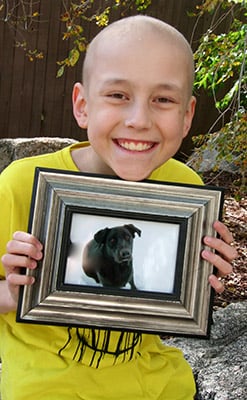
Young boy with his dog pen pal |
“Some of the children have said in their letters ‘I like writing to you because you don’t judge me like my friends at school do,’ or ‘I can share with you because you understand. You know what it’s like to get poked and what it’s like to get chemo,’” Gillespie says.
The people who wrote letters on behalf of their pets also formed a strong connection with the patients.
“One pet owner wrote to me ‘my dog has another dimension to his life because he gets to write letters,’” Gillespie says. “Parents have sent me thank you cards and emails telling me what a difference the program made. One mother still has a binder full of all the letters a dog sent to her daughter, and she looks through them once in a while because it makes her happy to see what made her daughter happy while she was alive.”
Gillespie says many in the group stay in touch. Some pet owners have attended memorial services for children who did not survive their cancer ordeals.
YAPS volunteers went through a rigorous screening process. As a precaution against red flags, Gillespie read correspondence between the patients and the pet owners and never found any inappropriate comments exchanged. However, the correspondence has helped inform her qualitative research about the project, published in the National Library of Medicine’s PubMed.gov site.
“Being a pediatric oncology nurse can be emotionally gut-wrenching for sure,” she says. “You’ve got to have some fun to balance the pain. YAPS brought fun and levity to the darkest days. No matter how many pokes and chemo I had to give or how much bad news I was a part of, I could sit with a child and show them a book of dogs and cats and witness them choosing a pen pal and get them started on a letter-writing project.”
While programs like YAPS obviously won’t “cure” cancer, Gillespie is interested in learning why and how animal-assisted intervention can make a difference in the health and well-being of pediatric cancer patients.
“The evidence is mounting quite rapidly that AAI does improve health,” she says. “Since I am not drawing blood or measuring salivary biomarkers in these children, I am trying to demonstrate how it works through what they are saying in their letters – how their narratives are an expression of perceived quality of life and a happier mood. We need both quantitative and qualitative research to make that case.”
“I love having an area of research that excites me and that I can see is making a difference for children with life-threatening illnesses.”
– Anne Gillespie, MSN, RN, CU College of Nursing PhD student
Taking the next step with a PhD
In 2016, Gillespie was accepted into a research fellowship program while still working as a nurse at Children’s Hospital Colorado and managing YAPS.
“I was getting to the point where I realized that if this program was going to grow and evolve like I wanted it to, I needed some evidence behind it,” she says. “So, I was really excited to get into this research fellowship program. That’s where I met nurse scientists at CU College of Nursing and got bit by the research bug.”
One of Gillespie’s supportive mentors in the fellowship was CU Nursing Associate Professor Madalynn Neu, PhD, RN, whom inspired Gillespie to pursue her PhD.
“Dr. Neu said she’d stay by my side until I got my degree – even if she retired along the way,” Gillespie says. “I thought ‘wow, she really believes in my potential and my research and will stick with me.’ That’s why I chose CU College of Nursing and within a year of starting the fellowship, I was enrolled in the master’s to PhD program.”
CU Nursing Associate Dean of Research and Scholarship Teresa Hernandez, PhD, RN, is another strong mentor who encouraged Gillespie on her research path.
In late 2020, Gillespie decided to focus her energy exclusively on earning her PhD. Concurrently, she’s working on a nurse educator certificate. Gillespie also found an ally with Vanderbilt School of Nursing Professor Mary Jo Gilmer, PhD, MBA, RN-BC, her external mentor, who also has published research regarding AAI.
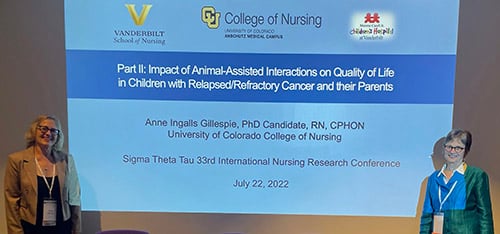
Anne Ingalls Gillespie, MSN, RN, PhD Student at CU Nursing & Vanderbilt School of Nursing Professor & Mentor, Mary Jo Gilmer, PhD, MBA |
Being a PhD student at CU Nursing has further invigorated Gillespie’s passion for nursing, animal-assisted intervention and research.
“I love thinking critically and creatively, and like a scientist,” she says. “I love having an area of research that excites me and that I can see is making a difference for children with life-threatening illness.”
What’s next for Gillespie?
On track to graduate in spring 2023, Gillespie says her next phase in her career is to pursue a post-doctoral research fellowship doing a randomized control trial in AAI for kids with cancer while positioning herself for an academic faculty research position at a college of nursing.
Though the YAPS program – which she owns – is essentially dormant for now, she wants to continue making her research available to other institutions to support AAI and the YAPS model.
“YAPS sort of outgrew me and needed more funding to reach more children,” Gillespie says. “It will find other chapters and other homes. When I have a PhD, the program will be eligible for funding that wasn’t available before. I’m hoping others will see this as an intervention that will make a difference in a child’s quality of life while dealing with cancer.”
She remains resolute in continuing what she started 21 years ago.
“There are some great peer-to-peer support programs for kids and young adults with cancer, but there’s something special about a relationship with an animal and the safety and privacy of writing letters; when talking to another person isn’t as accessible or inviting,” she says. “There are a lot of questions I’ve barely started to analyze.”

